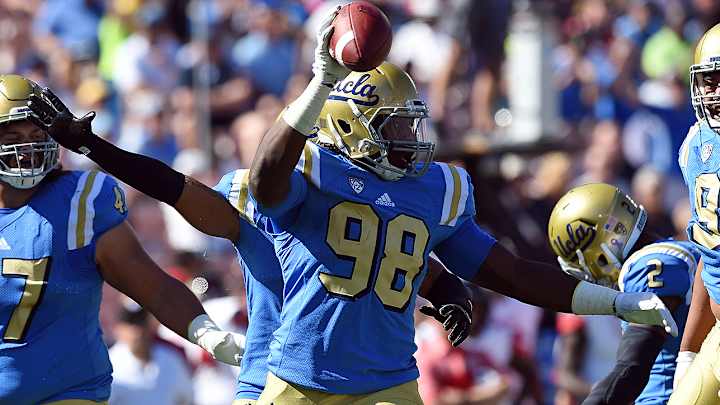2017 NFL draft prospect countdown, No. 33: Takkarist McKinley, DE/OLB, UCLA

What you need to know: After a 2013 season spent at Contra Costa College (Calif.), McKinley drew interest from a long list of prestigious programs—Oklahoma, Nebraska, USC. He chose UCLA, where he developed into an All-Pac-12 performer. This past season, McKinley finished second in the conference in tackles for loss (18.0) and third in sacks (10.0). McKinley, an Oakland native, notched three multi-sack performances, highlighted by a 3.0-sack showing against Utah last October. He also forced two of his six career fumbles in that Utah game and blocked a punt in 2015 against UNLV. Whichever team drafts him will have to wait on his on-field arrival: McKinley required shoulder surgery (torn labrum, fractured glenoid) after the combine.
Want more NFL draft coverage? Subscribe to the On the Clock Podcast here
Strengths: So much of McKinley’s production comes off not his initial surge but his second and even third efforts. There are pros and cons to that (we’ll get into the cons shortly). The upside is high-energy defense for 60 minutes, and that effort level alone poses problems for opposing offenses. Want to run a slow-developing play McKinley’s direction? Good luck holding that block. Quarterback stuck in the pocket? McKinley eventually will get there.
“I’m young and I feel like I got a motor that’s probably the best in the class right now,” McKinley said. “I’m hungry. I’ve got a lot to improve on, technique-wise. But once I improve on my technique, with my motor and my hunger of the game, I feel I’ll be unstoppable.”
McKinley ran a 4.59-second 40 at the combine, so he does have the speed to blow by offensive tackles. When that doesn’t work, his most effective method of breaking free is a spin move back inside. The rest comes from typical hand fighting up front.
He rarely runs himself out of position, either, hence his ability to swing back and pick up late tackles or sacks. McKinley displays a solid understanding of what he’s seeing, and he repeatedly snuffed out misdirection plays. The 61 tackles he delivered in 2016 are a testament to his active work against the run.
McKinley can stand up or play with his hand in the dirt. UCLA even moved him off the ball at times to employ him as an A-gap blitzer—his burst came in handy there.
Weaknesses: As McKinley himself admitted in that above quote, he is very much a work in progress as a pass rusher. He makes a ton of effort plays, but those plays are there to be had because his initial probing tends to come up empty. Offensive tackles can get their hands into his body and hold him in neutral, at least for awhile.
His speed does allow McKinley to turn the corner, on occasion, but he doesn’t have much in the way of a rip or swim move if he meets resistance and (so far) has not been a speed-to-power force. Other edge rushers in this class are more nimble at bending the corner, too.
Aside from his 40 time, he tested rather poorly in agility drills at the combine. That plus his relative lack of experience dropping in coverage could add obstacles in the way of a full-time 3–4 OLB role.
NFL player comparison: Willie Young (but faster)
